9+ Sample Mediation Settlement Agreements
-
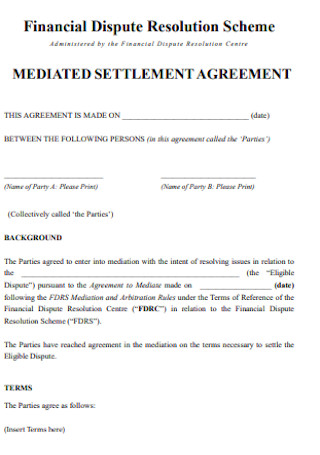
Mediation Financial Settlement Agreement
download now -
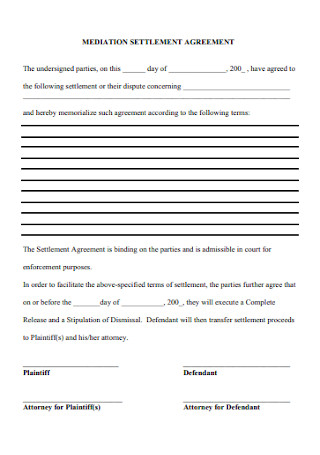
Basic Mediation Settlement Agreement
download now -
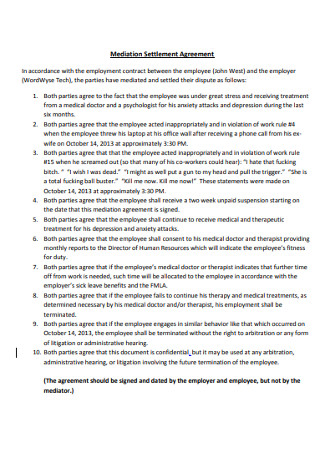
Sample Mediation Settlement Agreement
download now -
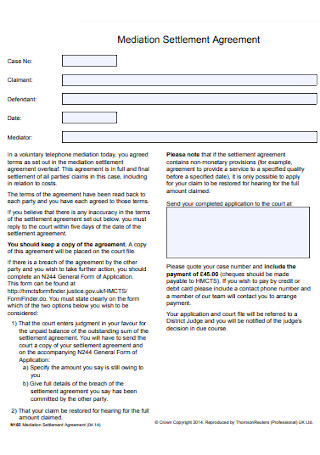
Mediation Settlement Agreement Format
download now -
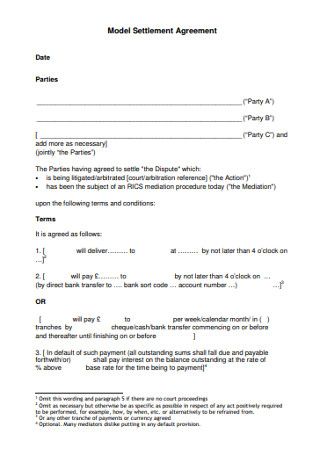
Model Mediation Settlement Agreement
download now -
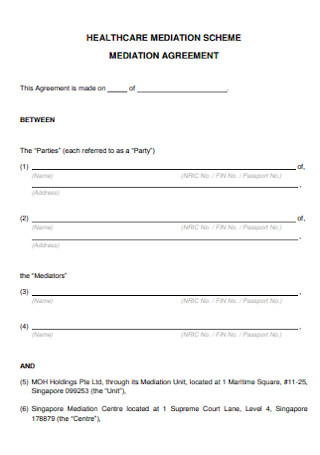
Healthcare Mediation Settlement Agreement
download now -
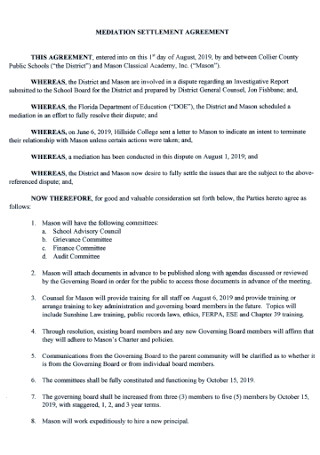
Simple Mediation Settlement Agreement
download now -
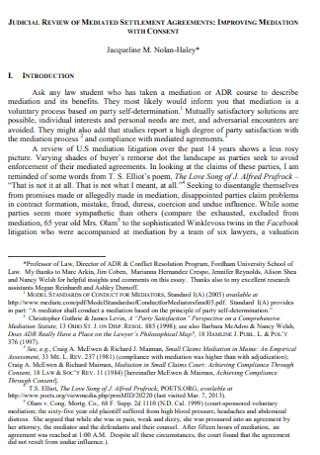
Judicial Review of Mediation Settlement Agreement
download now -

Judicial Review of Mediation Settlement Agreement
download now -
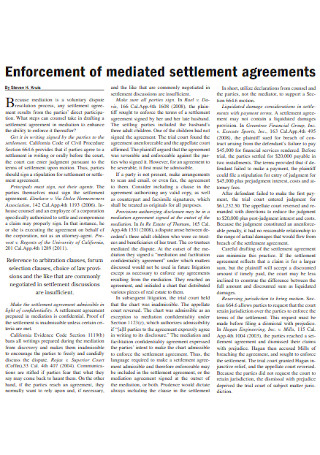
Enforcement of Mediated Settlement Agreement
download now
FREE Mediation Settlement Agreement s to Download
9+ Sample Mediation Settlement Agreements
What Is a Mediation Settlement Agreement?
Benefits of Mediation
Tips for a Successful Mediation Statement
How to Manage and Resolve Workplace Conflict
FAQs
What advantages does mediation have over negotiation?
Why is mediation the best?
Do both sides pay for mediation?
What Is a Mediation Settlement Agreement?
A mediation settlement agreement is a legal record that outlines the terms and circumstances agreed upon by the parties during the mediation process. A mediator is a neutral third group who negotiates an arrangement between conflicting parties. Mediation can occur in various legal contexts, including divorce agreements, real estate statements, and corporate dissolutions. A mediation settlement agreement results from an operational procedure guided by a neutral third-party mediator between all parties.
Benefits of Mediation
Disputed parties considering mediation to resolve their disagreements frequently want to know what mediation may accomplish. Although no method of dispute resolution can guarantee precise results, the following are some common advantages of mediation:
Tips for a Successful Mediation Statement
A correctly crafted mediation statement can aid a mediator in formulating an effective settlement strategy. It is simply too risky to leave a case’s outcome in the hands of a group of persons who did not volunteer to decide it. Accordingly, mediation is one of the most crucial aspects of a case and one of the defining moments for a lawyer’s success in commercial litigation. A solid confidential mediation statement can serve as a vision roadmap for the mediator to assist you in achieving a favorable outcome. Here are five suggestions for crafting a more persuasive confidential mediation statement.
1. Be Upfront
In the first paragraph, you should tell the mediator you work for, who the other side is, a summary of the claims, and what’s at stake. This needs to be short and precise. This may seem an obvious suggestion, but too many lawyers start their opening statements with several paragraphs of background information instead of a summary of who the parties are and the case. Then the mediator must go through pages of facts and figure out why they are essential. Start with a summary report of who the parties are before getting into the facts and details of the claims.
2. Provide a Short Overview of the Facts and Assertions
The following should include specifics to help the mediator rapidly understand the essential facts and their relationship to the issue. The attorneys will need to be more knowledgeable about the facts than the mediator, and they need to be. To establish tactics to assist the parties in resolving the dispute, the mediator must understand the parties’ essential facts and history. The mediator will need more time and patience to read an appellate brief. Use headings and bullet points to arrange the section and describe the parties’ claims, defenses, and background statements. This approach makes it much simpler for the mediator to obtain the essential information fast. Using the same structure, you should also provide a synopsis of the state of the case, the discovery process, and important dates such as summary judgment evaluations or the trial.
3. Summarize Earlier Settlement Discussions
The mediator needs to know what has been done in the past to try to solve the problem. This section should clarify all demands and offers, including important rulings or depositions before or after an order or request was made and how they affected earlier talks. If there have been no settlement talks, explain why. Based on past efforts, this information will help the mediator devise an affirmative action plan before the mediation.
4. Recognize Your Talents and Shortcomings
This is a crucial component of a summary of a mediation. A competent attorney will not just emphasize the case’s strengths but will also identify any shortcomings in the facts or the law. Frequently, a client has vision statement and views a matter from an emotional or limited perspective, and his attorney cannot help him see the other side. A mediator can assist an attorney in persuading both an opponent and her client that there are flaws and that compromise may be necessary. It is helpful to disclose factual and legal deficiencies in a mediation agreement so that the mediator can begin crafting a strategy to help both parties reach a compromise. If critical documents or deposition testimony need to be summarized, this is the place to do so. Be mindful, however, that the majority of mediators will not take the time to learn the facts, so be concise and utilize a summary structure. You can then bring up the details during the mediation, with the mediator having some familiarity with them.
5. Bring It Home
Close your mediation statement with a proposed course of action. If you believe it would be beneficial for both parties to make opening comments at the beginning of the mediation, explain why and what you intend to achieve. If opening remarks could drive the parties further apart, given the level of hostility at that moment, or if the parties have already seen their attorneys in action and opening statements would be a waste of time, say so. However, your conclusion should provide the mediator with a suggested beginning point for the session and indicate how you expect it to lead to a resolution.
How to Manage and Resolve Workplace Conflict
Conflict is not an uncommon occurrence for humans. Humans experience it in their daily lives — with their friends, families, and especially in their careers. Conflict in the workplace produces a great deal of frustration, anguish, discomfort, despair, and fury. It is a common component of existence. Today, firms hire personnel from a variety of geographical areas, cultural and intellectual backgrounds, and differing points of view. In a workplace where individuals have divergent perspectives on the same issues, disputes are inevitable. The following are some conflict management and resolution strategies for the workplace.
1. Specify the Origin of the Disagreement
The initial stage in settling a conflict is determining its origin. Selecting the source of the disagreement will allow you to comprehend how the problem grew in the first place. In addition, you will be able to convince both parties to decide on the nature of the issue. And to accomplish so, you must discuss the unmet requirements on both sides of the problem. Additionally, you must ensure mutual understanding. Obtain as much information as possible regarding each side’s perspective. Continue to ask questions until you are confident that all parties involved in the conflict grasp the issue.
2. Find a Secure and Private Location to Speak
People frequently ask, “What is a calm method of problem-solving?” To have a productive conversation, you must select a safe setting in which to speak. Additionally, you can take the required risks for open dialogue with the issues at hand in such a setting. Therefore, choose a safe and private location to converse before attempting to address any issue. Do not choose either party’s office or a site near them. And while at this location, ensure that each party has ample opportunity to express their opinions on the issue.
3. Actively Listen and Permit Everyone to Speak
Allow each party to express their opinions and impressions about the matter after bringing both sides together in a safe and confidential setting. Give both parties equal time to voice their opinions and concerns without favoring one. Take a confident, strong stance throughout the meeting. Establish ground rules if necessary. Using this strategy will urge both parties to express their ideas openly and honestly, as well as to understand the reasons behind the disagreement and find solutions.
4. Investigate the Situation
Take the time to look into the situation after hearing the parties’ worries. Don’t prejudge or make a decision based on the information you know. Investigate more about the events, parties involved, problems, and reactions. Have a private, assured dialogue with the parties involved and pay close attention to what they are saying by listening intently. You can accomplish this by paraphrasing their comments and repeating them to them. Additionally, look for any underlying roots of the conflict that might not be obvious or noticed immediately.
5. Determine Means to Achieve the Shared Objective
When managing conflict processes, you must have a clear goal of resolving the issue and preventing its recurrence. And to solve any problem, you must understand the many stages of conflict. This will allow you to seek the optimal means to achieve the common objective. After determining the source of the dispute, speaking with both sides, and studying the situation, you must sit down with both parties and discuss the shared strategies you might employ to achieve the common objective: managing and resolving the current issue. Listen, communicate, and collaborate until all choices have been exhausted.
FAQs
What advantages does mediation have over negotiation?
Parties who negotiate their settlements have more significant influence over the result of their dispute, and their benefits and losses are more predictable when they have the right to decide, as opposed to when third parties determine the conclusion.
Why is mediation the best?
Mediation allows the parties to explore their difficulties, clarify misunderstandings, and identify areas of agreement in a manner that would never be feasible in a judicial proceeding.
Do both sides pay for mediation?
Most mediation firms list their rates per person per hour or person per session. This is because, in most instances, each party pays its fees for the length of the service. It implies that each party is vested in moving matters forward and reaching an agreement.
Mediation is an alternative to costly, emotionally draining, and time-consuming processes such as litigation. It is appropriate for individuals who are willing to engage with the opposing side and strive to understand better and resolve their disagreement with the assistance of a skilled third party. Are you prepared to compose your very own Mediation Settlement Agreement? We are cheering you on!
